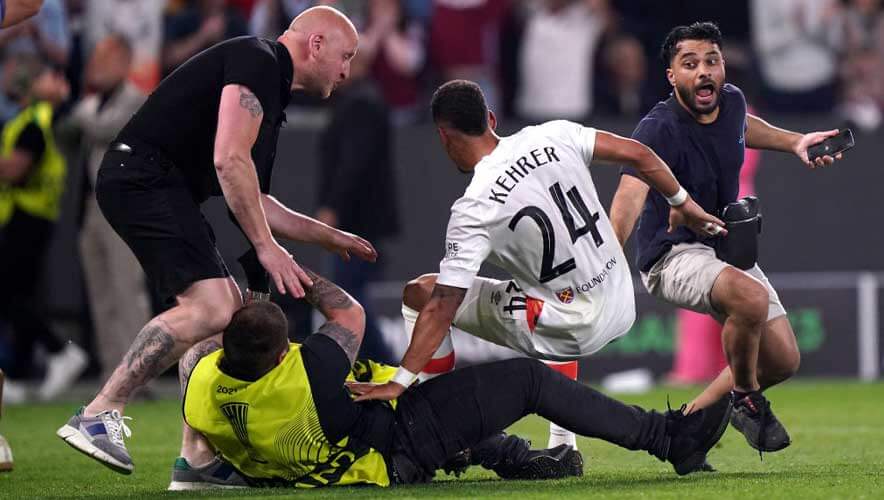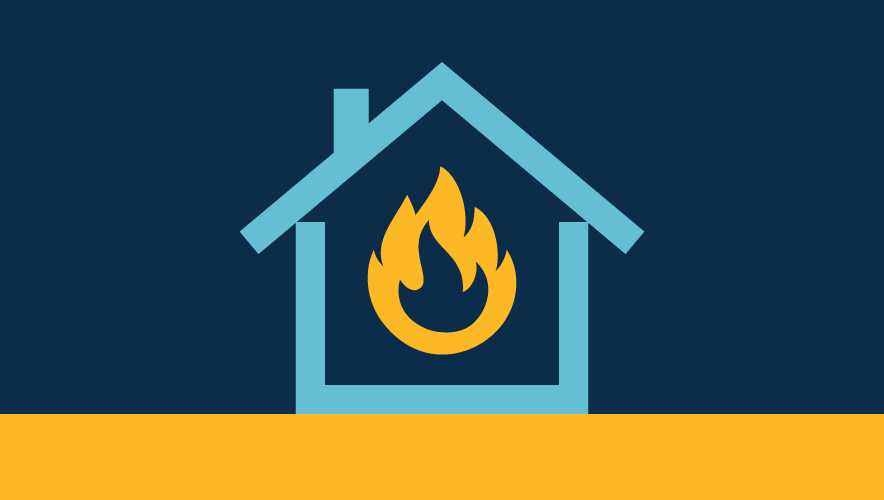The Security Scorecard: Considerations for Sport Venue and Event Managers
Negative fan behavior. Weather issues. Cyberattacks. Rogue drones. Security incidents at sporting events are impacting athletes, fans, and stadium staff, as well as making headlines in the media.
In the past year, stadium security guards have intercepted both on-field intruders and fans rushing the field after an unexpected victory. Court storming incidents at NCAA basketball events are cause for concern as they have injured fans, staff, officials, and high-profile athletes.
Other incidents, such as a crowd crush at a white-out game at Penn State and sustained injuries from a lightning strike at a UCF game, are also concerning. National news of active shooters, along with the constant threat of terrorism, accentuate the importance of preparedness.
Venues face multiple challenges regarding safety and security; therefore, venue security directors around the world must remain vigilant and prepare for similar threats and attacks.
Fan Behavior
Negative fan behavior such as vandalism, alcohol abuse, fights between patrons, violence against staff members, rushing field of play, and use of weapons are all areas of concern for security managers.
The National Center for Spectator Sports Safety and Security (NCS4) )Venue Security Director Industry Research Report indicates that approximately 65 percent of venue directors believe fan behavior has worsened since the return from COVID-19 isolation. It appears that spectators seem to have a higher disregard for policies and procedures. This may account for increased inappropriate fan behavior, such as court storming, fights between patrons, property damage, and alcohol abuse.
Weather-related incidents are becoming more prevalent due to extreme conditions.
Recently, court storming was in the news again following high-profile college basketball games in the United States, where hundreds of fans rushed the court after major wins. In one incident, a fan knocked over University of Iowa player Caitlin Clark. In another, a fan ran into Duke player Kyle Filipowski, injuring him.
Other acts of fan violence, such as fights between patrons, have escalated. In 2023, a New England Patriots fan died after an altercation with a Miami Dolphin’s fan inside the venue. Viral video footage has revealed other occurrences during multiple professional sporting events. A common denominator of many of these fights is overindulgence in alcohol.
Leagues are mitigating inappropriate fan behavior by increasing communication on the fan code of conduct and the importance of spectators reporting incidents. Leagues are making efforts to hold spectators accountable for their actions by immediately ejecting fans from games, reneging season tickets, banning individuals from future games, or requiring educational training in the code of conduct.
Staffing Shortages
Since COVID, there has been a significant shortage of security staffing as noted by the NCS4 report. Security directors cited multiple reasons for these shortages, including a lack of qualified applicants, non-competitive wages, lack of interest, no-shows, and budget constraints.
These shortages are common in other venue areas, such as concessions, ushers, and ticket takers. The ripple effect of these shortages may include longer wait times for entry, concessions, and merchandise, which may cause fans to become frustrated.
This behavior can escalate without the presence of security. Venue directors must deploy an adequate level of security staff based on specific event risks. Crowd dynamics, gameday promotions, celebrity appearances, game rivalry/intensity, and even the event time may cause changes in the number of staff needed, along with their positioning at the event. These staff should be trained in crowd control, alcohol management, and de-escalation techniques.
Weather Concerns
Weather-related incidents are becoming more prevalent due to extreme conditions. For example, multiple fans suffered from hypothermia and frostbite symptoms at a Kansas City Chiefs playoff game, and at the Tokyo Olympic Games, more than 110 athletes suffered from heat-related illnesses.
Sports venue and event leaders are reviewing the science and making policy changes regarding new information. For instance, wet bulb temperatures (which combine dry air temperature with humidity) are used to determine unsafe heat environments. Depending on the event, some organizations provide cooling, water, and heating stations to combat these extreme conditions for players and spectators. For example, in 2023, the Tennessee Titans turned their first aid stations throughout Nissan Stadium into cooling stations for fans and set up misting stations.
Moreover, lightning has posed the most dangerous threat to the general population in the United States and disrupted sporting events. The National Lightning Safety Council reports that lightning occurs around 40 million times a year, injuring thousands and killing 480 people between 2006 and 2023. Most lightning incidents occur near a safe place where individuals can shelter and prevent harm.
However, participants, professionals, and spectators at sporting events may be unaware or even negligent in taking the necessary lightning safety measures and following recommended safety procedures. Therefore, security managers should consider severe weather activity as part of their risk assessments and emergency response plans.
Whether venues have access to a certified meteorologist on-site, sports managers should partner with national weather organizations (e.g., the National Oceanic and Atmospheric Administration (NOAA) or the National Weather Service) to share information and resources to mitigate such dangerous natural phenomena.
Cyberthreats
New threats and challenges arise as technology evolves. Due to the advancement of technology and the vast digital surface of facilities, criminals search for vulnerabilities to exploit. Cyberattacks may damage the sport organization’s reputation and brand, potentially causing damage or disruption to their operations.
The UK’s National Cyber Security Centre revealed that more than 70 percent of sports organizations in 2020 had experienced a cyber breach. The primary motive for these breaches is financial in nature. Attacks typically include phishing, credential stuffing, and password spraying. Targeted areas may include video surveillance, facial recognition, e-ticketing, cashless venues, frictionless checkout systems, and personal identifiers of employees and fans. Criminals may even try to access spectators’ phone data as they connect to unsecured Wi-Fi.
In 2022, the San Francisco 49ers reported that their facility was hit by a ransomware attack a day before the Super Bowl. BlackByte, a ransomware gang, purportedly listed 2020 team financial data on the Dark Web. The 49ers reported a disruption in its network systems and hired cybersecurity firms to assist with the breach. They also notified law enforcement.
The same year, personal data belonging to Major League Baseball (MLB) players and their family members was stolen in a cyberattack against a third-party vendor called Horizon Actuarial Services, LLC. More than 38,000 individuals were affected were affected by this Incident.
An attack on the Houston Rockets in 2021 claimed 500 gigabytes of data, including contracts and financial data, had been stolen. The Babuk group was allegedly responsible for the attack and listed a ransom message on the Dark Web for payment.
Venues must maintain a robust cybersecurity defense system and provide basic cyber hygiene training to staff members with access to their network infrastructure. Sporting venues should include periodic monitoring and auditing of personal and organizational social media accounts and ensure the latest updates are installed on all software.
Terrorism
Terrorism remains a significant threat to sports venues, even though methods of attack have evolved since 9/11. Common types of attack methods used by terrorists include active shooters, suicide bombings, vehicular bombings, vehicular ramming, cyberattacks, drone attacks, and chemical, biological, radiological, and nuclear (CBRN) attacks.
Although these malicious activities are not always terrorist-related, venue directors must ensure that measures are in place to prevent such actions. Active shooters are cause for concern as the number of mass shootings continues to increase in the United States.
During the Super Bowl victory parade in Kansas City in February 2024, 22 people were shot and one person was killed when a personal dispute escalated into gunfire.
Sports organizations should consider hardening their facilities with appropriate technology solutions. Gun detection technology and video surveillance cameras are helpful for the facility’s perimeter, including parking lots and tailgating areas, as this technology can identify exposed weapons and be used to track their location while security personnel respond.
Other solutions for mitigating terrorist threats include adequate security presence, walk-through metal detectors, bag searches, facial recognition systems, explosive particle detectors, explosive detection canines, barricade and bollards systems, and surveillance cameras.
UAV Threats
Drones or uncrewed aviation systems (UAVs) have the potential to carry explosive devices and weapons to be used for malicious purposes. Criminals can use UAVs to monitor areas from the sky for nefarious purposes, perform cybercrimes involving theft of trade secrets, technologies, or sensitive information, and disrupt or invade the privacy of others.
In 2022, a college and professional football game was delayed more than 10 minutes due to unauthorized drones flying over the stadiums. In 2020, rogue drones interrupted at least five MLB games. Illegal drones have also crashed into stadium seating at major sporting events, such as the U.S. Tennis Open in New York and an MLB game in San Diego.
More than 70 percent of sports organizations in 2020 had experienced a cyber breach.
U.S. federal guidelines prohibit drones from flying in and around major sporting venues one hour before and one hour after the event. However, as noted above, there have been numerous incidents in which rogue drones have infiltrated this protected airspace.
Currently, facilities can use drone detection technology, which identifies rogue drones, the operator, and the operator’s location; however, facilities do not have the authority to neutralize the drone or punish the perpetrators. This responsibility currently resides with the U.S. Department of Homeland Security (DHS), the U.S. Department of Justice (DOJ), and the Federal Aviation Administration (FAA). The U.S. Congress is considering changes to allow public safety agencies (i.e., local law enforcement) greater oversight and response capabilities to unidentified drones.
Although drones typically receive bad publicity, they can be essential in protecting the facility. Drones are cost-effective and can easily monitor crowds and inspect perimeter areas by supplying real-time video. They can detect gunshots/explosions, locate missing fans, assist with public address announcements, and even sanitize and disinfect a facility.
For example, in 2020, during the COVID outbreak, the Mercedes Benz Stadium deployed drone technology to assist in disinfecting the venue. It was reported that these drones reduced the time spent cleaning the venue by 95 percent.
Next Steps for Security Managers
Sports venues and event managers should consider conducting periodic and event-specific risk assessments to identify threats and vulnerabilities. Outcomes from this process will inform planning efforts, including the development of policies and procedures.
Recruiting, training, and retaining staff is essential. Conducting exercises (i.e., tabletop or operational exercise) can help identify capability gaps to be addressed before events and enhance multiagency collaboration among public safety team members.
Venue and event managers can leverage available resources through academic centers, government agencies, and professional associations. For example, NCS4 provides numerous educational resources, such as training in risk management, incident management, evacuation planning, crisis communications, and crowd management. Other resources include industry best practices, patron screening guides, and cybersecurity considerations.
Enjoying a sporting event to the fullest requires safety and security measures to be in place. Many measures typically go undetected by most spectators; however, they serve a vital role in detecting and responding to a potential threat. The venue’s proactive response to such incidents speaks volumes about its preparedness, which can build reputational trust amongst all stakeholders.
However, an ill-prepared response may deter future attendance and cause litigation cases against the facility. Venues must stay current in risk mitigation techniques and provide continuous training for staff so that incidents are reduced to a minimum with the least damage. Security directors can’t prevent all accidents, but they can drastically reduce the impact by being prepared.
Dr. Brandon Allen is the director of research at the National Center for Spectator Sports Safety and Security (NCS⁴) at The University of Southern Mississippi. Allen is responsible for annual industry research reports, research seminar series, conducting academic scholarly research, managing the research affiliate program, and assisting with other duties and responsibilities pertaining to the mission and vision of NCS⁴.
Dr. Stacey Hall is the executive director at the National Center for Spectator Sports Safety and Security (NCS4) and professor of sport management at The University of Southern Mississippi. Hall's expertise is in the area of sport safety and security management, and her research has been published in many journals on sport management, homeland security, and emergency management. She has coauthored or authored numerous textbooks and chapters on sport facility and event management, crisis communications, and emergency response and recovery.
© Brandon Allen and Stacey Hall











